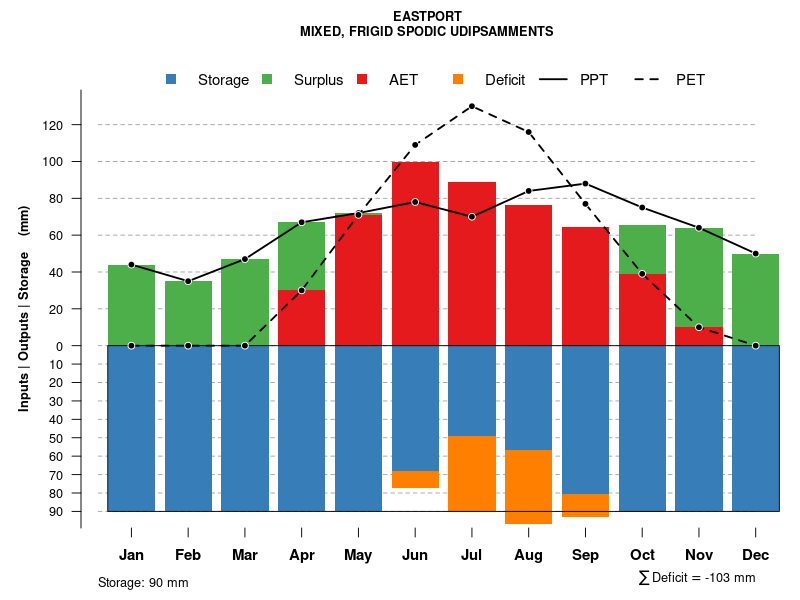| Eastport sand, 0 to 6 percent slopes | 11B | 393 | 190242 | 6cyv | mi001 | 1993 | 1:20000 |
Eastport sand, 0 to 6 percent slopes | 11B | 108 | 191249 | 6f0b | mi007 | 1998 | 1:12000 |
Eastport-Rubicon sands, 0 to 6 percent slopes | ErB | 2829 | 189151 | 6btn | mi011 | 1964 | 1:20000 |
Eastport-Rubicon-Roscommon association, undulating | EtB | 1915 | 189159 | 6btx | mi011 | 1964 | 1:20000 |
Eastport-Rubicon association, rolling | EsC | 1170 | 189158 | 6btw | mi011 | 1964 | 1:20000 |
Eastport-Grattan sands, 6 to 12 percent slopes | EgC | 873 | 2673440 | 2qz4p | mi011 | 1964 | 1:20000 |
Eastport-Grattan sands, 0 to 6 percent slopes | EgB | 412 | 2673439 | 2qz4n | mi011 | 1964 | 1:20000 |
Eastport-Rubicon sands, 6 to 12 percent slopes | ErC | 392 | 189152 | 6btp | mi011 | 1964 | 1:20000 |
Adrian-Eastport-Rubicon association, undulating | AeB | 292 | 189107 | 6bs7 | mi011 | 1964 | 1:20000 |
Eastport-Rubicon sands, 6 to 12 percent slopes, moderately eroded | ErC2 | 121 | 189153 | 6btq | mi011 | 1964 | 1:20000 |
Eastport-Grattan sands, 12 to 18 percent slopes | EgD | 114 | 2673442 | 2qz4r | mi011 | 1964 | 1:20000 |
Eastport-Grattan association, rolling | EhC | 96 | 2673445 | 2qz4v | mi011 | 1964 | 1:20000 |
Eastport-Grattan sands, 12 to 18 percent slopes, moderately eroded | EgD2 | 50 | 2673443 | 2qz4s | mi011 | 1964 | 1:20000 |
Eastport-Rubicon sands, 12 to 18 percent slopes | ErD | 39 | 189154 | 6btr | mi011 | 1964 | 1:20000 |
Eastport-Grattan sands, 25 to 45 percent slopes | EgF | 30 | 2673444 | 2qz4t | mi011 | 1964 | 1:20000 |
Eastport-Grattan sands, 6 to 12 percent slopes, moderately eroded | EgC2 | 27 | 2673441 | 2qz4q | mi011 | 1964 | 1:20000 |
Eastport-Rubicon sands, 18 to 25 percent slopes, moderately eroded | ErE2 | 24 | 189156 | 6btt | mi011 | 1964 | 1:20000 |
Eastport-Rubicon sands, 25 to 45 percent slopes | ErF | 22 | 189157 | 6btv | mi011 | 1964 | 1:20000 |
Eastport-Rubicon sands, 12 to 18 percent slopes, moderately eroded | ErD2 | 7 | 189155 | 6bts | mi011 | 1964 | 1:20000 |
Eastport-Grattan sands, 0 to 6 percent slopes | 123B | 23 | 2673575 | 2qz4n | mi017 | 1978 | 1:20000 |
Eastport-Grattan sands, 12 to 18 percent slopes | 123D | 2 | 2673576 | 2qz4r | mi017 | 1978 | 1:20000 |
Eastport sand, 0 to 6 percent slopes | EdB | 1027 | 190425 | 6d4r | mi029 | 1970 | 1:15840 |
Eastport sand, 6 to 12 percent slopes | EdC | 512 | 190426 | 6d4s | mi029 | 1970 | 1:15840 |
Eastport sand, 0 to 6 percent slopes | 25B | 1124 | 190555 | 6d8y | mi031 | 1988 | 1:15840 |
Eastport sand, 12 to 25 percent slopes | 25D | 288 | 190556 | 6d8z | mi031 | 1988 | 1:15840 |
Eastport-Roscommon sands, 0 to 6 percent slopes | EeB | 3386 | 1588048 | 1q9hc | mi041 | 1969 | 1:24000 |
Eastport sand, 0 to 6 percent slopes | EdB | 2970 | 1588047 | 1q9hb | mi041 | 1969 | 1:24000 |
Roscommon-Eastport sands, 0 to 6 percent slopes | ReB | 2028 | 189366 | 6c1l | mi047 | 1968 | 1:20000 |
Eastport sand, 0 to 6 percent slopes | EdB | 1988 | 189330 | 6c0f | mi047 | 1968 | 1:20000 |
Lake beach and Eastport sand, 0 to 6 percent slopes | LeB | 700 | 189498 | 6c5v | mi055 | 1963 | 1:15840 |
Eastport-Roscommon sands, 0 to 2 percent slopes | ErA | 368 | 189411 | 6c31 | mi055 | 1963 | 1:15840 |
Eastport sand, 0 to 6 percent slopes | EdB | 6434 | 190791 | 6djk | mi089 | 1967 | 1:20000 |
Eastport-Leafriver complex, 0 to 35 percent slopes | 38E | 10503 | 416398 | fz96 | mi097 | 1994 | 1:20000 |
Eastport sand, 15 to 35 percent slopes | 17E | 4642 | 416362 | fz81 | mi097 | 1994 | 1:20000 |
Eastport sand, 0 to 15 percent slopes | 17D | 856 | 416361 | fz80 | mi097 | 1994 | 1:20000 |
Eastport sand, 1 to 8 percent slopes | 67B | 1009 | 190931 | 6dp2 | mi141 | 1989 | 1:15840 |
Eastport sand, 0 to 6 percent slopes | EaB | 1930 | 187413 | 690l | mi147 | 1969 | 1:20000 |
Eastport sand, 6 to 18 percent slopes | EaC | 435 | 187414 | 690m | mi147 | 1969 | 1:20000 |
Eastport, Arenac, and Kalkaska sands, 2 to 7 percent slopes, slightly eroded | EaB1 | 339 | 188249 | 69wk | mi151 | 1955 | 1:15840 |
Eastport, Arenac, and Kalkaska sands, 0 to 2 percent slopes, slightly eroded | EaA1 | 181 | 188248 | 69wj | mi151 | 1955 | 1:15840 |
Eastport fine sand and beach sand, 0 to 2 percent slopes | EbA0 | 154 | 188251 | 69wm | mi151 | 1955 | 1:15840 |
Eastport fine sand and beach sand, 2 to 18 percent slopes | EbC0 | 144 | 188252 | 69wn | mi151 | 1955 | 1:15840 |
Eastport, Arenac, and Kalkaska sands, 7 to 14 percent slopes, slightly eroded | EaC1 | 106 | 188250 | 69wl | mi151 | 1955 | 1:15840 |
Eastport sand, 0 to 6 percent slopes | EsB | 55 | 2508266 | 690l | mi151 | 1955 | 1:15840 |












